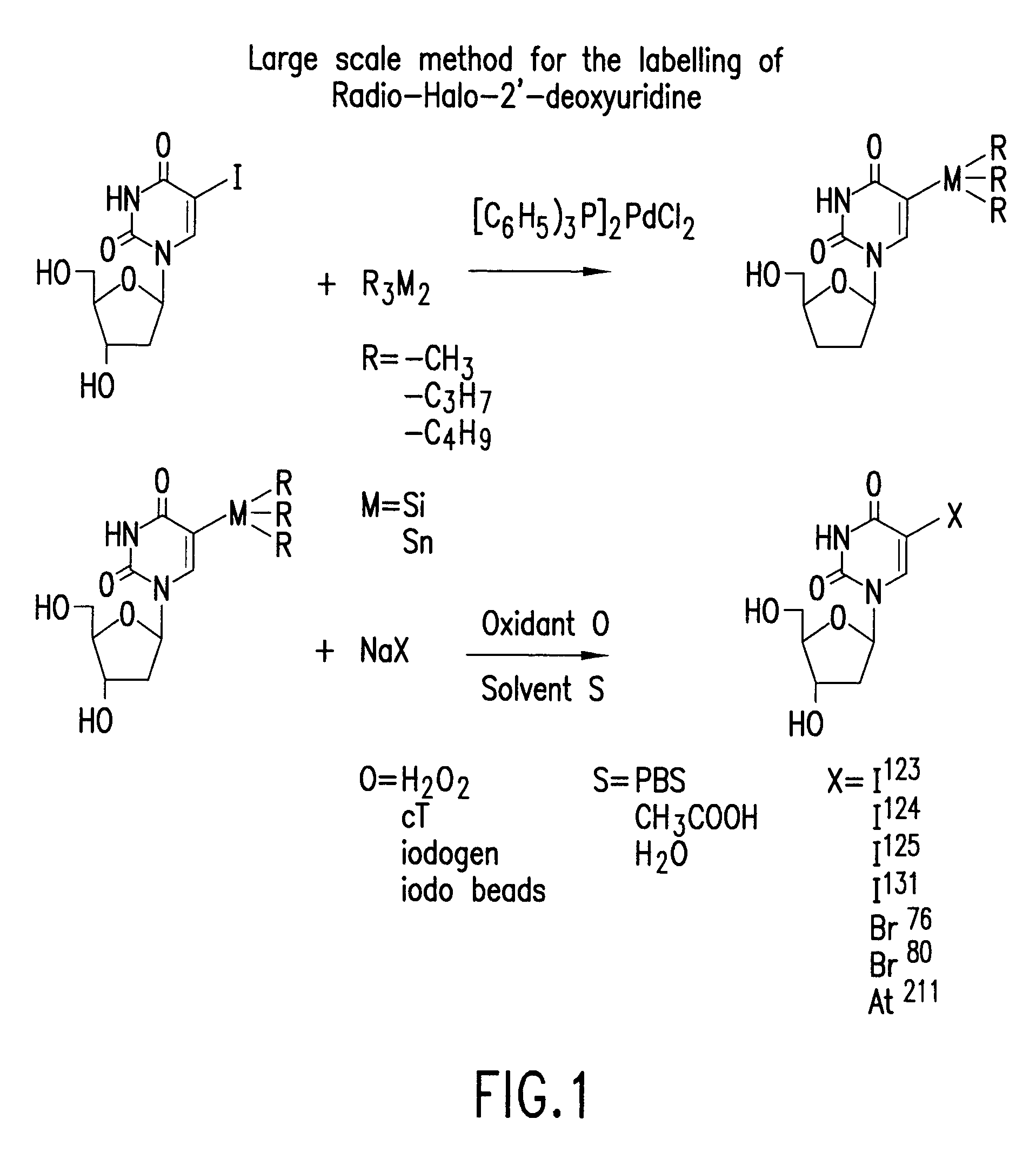System and method for the large scale labeling of compounds with radiohalogens
a radiohalogen and large-scale technology, applied in the field of large-scale method for making radiohalogenated compounds, can solve the problems of limited methods and the time required to produce the compound must be compatibl
- Summary
- Abstract
- Description
- Claims
- Application Information
AI Technical Summary
Benefits of technology
Problems solved by technology
Method used
Image
Examples
example 1
Production of Radio-Labeled IUdR
[0025]Seven mmol of unlabeled iododeoxuridine (IudR, 2.5 g) was dissolved in 100 ml anhydrous dioxane at 50° C. The solution was then cooled to room temperature. 0.125 g of bis(triphenyl phosphine) palladium dichloride and 6 g (15 mmol) of hexabutylditin were added and the mixture was refluxed for 6 hours at 110° C. under argon. The solvent was removed under vacuum and the product was redissolved in chloroform methanol 4:1 and purified by chromatography over a silica gel column, eluting with a linear gradient of 0 to 20% methanol in chloroform. The product elutes in the range of 10 to 15% methanol. (The gradient of 0 to 20% methanol is run over 50 collection tubes; the product elutes in tubes 25 to 30.) The product is identified by ultraviolet fluorescence or iodine staining of a silica TLC plate developed with hexane:ether 1:1. The desired Bu3SnUdR product was obtained as a pale yellow oil that exhibits a Rf of 0.3.
[0026]Na125I (200 mCi, produced by ...
example 2
Labeling Proteins
[0027]132 microliters of 0.1 molecular potassium phosphate buffer at pH 8.2 was added to a vial containing 100 micrograms of polyclonal anti-TSH antibody and stirred for 10 seconds. 7 mCi of Na125I was added to the solution. 40 microliters of chloramine T (CT) buffer solution at 1 mg / ml was added and stirred for 1 minute. 40 microliters of ascorbic acid buffer solution at 5 mg / ml was further added and stirred for 10 seconds. The iodinated polyclonal anti-TSH solution was then loaded into a G75 column (10 ml) and eluted with 0.01 M phosphate buffered saline at pH 7.4. 15 fractions in 13×100 MM test tubes were collected at the rate of 0.5 ml / tube at 2 minutes per tube (the product elutes in tubes 6-10). 1 ml of ascorbic acid buffer was added to a concentration of 1 mg / ml of 5% BSA phosphate saline buffer at pH 7.4. 4 mCi of 125I anti-TSH was obtained.
example 3
Labeling Steroids
[0028]Fifty microliters of DMF and 100 microliters of 0.2 M phosphate buffer at pH 7.4 was added to a vial containing 4 micrograms of Estradiol-6-CMO-Histamine Aliquot. 10 mCi of sodium I-125 was added to the solution and stirred for ˜10 seconds. 50 microliters of chloramine T (CT) solution at 1 mg / ml was further added to the mixture and stirred for 3 minutes. 50 microliters of ascorbic acid buffer was then added at 5 mg / ml and injected into an HPLC, using a methanol / water (MeOH / H2O) gradient. 0.5 ml fractions containing radioactivity were collected after 45 minutes. 10 ml of ethanol were added. 2.1 mCi of 125I Estradiol at a specific activity of about 2000 Ci / mmol was obtained.
PUM
| Property | Measurement | Unit |
|---|---|---|
| temperature | aaaaa | aaaaa |
| temperature | aaaaa | aaaaa |
| temperature | aaaaa | aaaaa |
Abstract
Description
Claims
Application Information
 Login to View More
Login to View More - R&D
- Intellectual Property
- Life Sciences
- Materials
- Tech Scout
- Unparalleled Data Quality
- Higher Quality Content
- 60% Fewer Hallucinations
Browse by: Latest US Patents, China's latest patents, Technical Efficacy Thesaurus, Application Domain, Technology Topic, Popular Technical Reports.
© 2025 PatSnap. All rights reserved.Legal|Privacy policy|Modern Slavery Act Transparency Statement|Sitemap|About US| Contact US: help@patsnap.com

